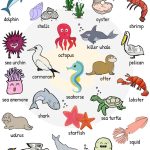Discover The Fascinating Ocean Animal Hierarchy: Dive Into The Depths Of The Ocean Animal Kingdom Now!
Exploring the Fascinating Ocean Animal Hierarchy
The ocean is a vast and mysterious ecosystem, teeming with an incredible diversity of life. From tiny plankton to massive whales, each creature plays a vital role in the complex web of the ocean animal hierarchy. In this article, we will delve into the depths of the ocean and uncover the secrets of this fascinating hierarchy.
What is Ocean Animal Hierarchy?
The ocean animal hierarchy refers to the organized structure and relationships among different species in the ocean. Similar to a food chain or a pyramid, it illustrates the flow of energy and resources within the underwater world. At the top of the hierarchy are the apex predators, which exercise control over the lower levels of the food chain.
2 Picture Gallery: Discover The Fascinating Ocean Animal Hierarchy: Dive Into The Depths Of The Ocean Animal Kingdom Now!


Who are the Key Players in the Ocean Animal Hierarchy?
The ocean animal hierarchy consists of various marine organisms, each occupying a specific position in the chain. At the apex of the hierarchy, we find mighty predators like sharks, killer whales, and swordfish. These top predators maintain the balance of the ecosystem by controlling the population of their prey.

Image Source: sciencelearn.org.nz
Below the apex predators are the secondary consumers, including seals, sea lions, and large fish species like tuna and marlin. They feed on smaller fish and invertebrates, playing an essential role in regulating the population of these species.
The next level in the hierarchy is occupied by primary consumers such as small fish, zooplankton, and filter-feeding organisms like krill. These creatures feed on microscopic algae and are a crucial link in the transfer of energy from the lower levels of the food chain.
Finally, at the base of the hierarchy, we have the primary producers. These are the primary sources of food in the ocean and include phytoplankton, seaweed, and other photosynthetic organisms. They convert sunlight into energy through the process of photosynthesis.
When and Where Does the Ocean Animal Hierarchy Occur?

Image Source: researchgate.net
The ocean animal hierarchy is present in all the world’s oceans, from the frigid Arctic to the tropical coral reefs. It is a constant and dynamic process that occurs throughout the year. However, the specific hierarchy and the species involved may vary depending on the region and the local ecosystem.
The ocean animal hierarchy is not limited to a specific time frame, as it is an ongoing cycle. It operates 24/7, with predators hunting and feeding on their prey, and primary producers absorbing sunlight and converting it into energy.
Why is Understanding the Ocean Animal Hierarchy Important?
Understanding the ocean animal hierarchy is crucial for several reasons. Firstly, it allows us to comprehend the delicate balance of the marine ecosystem and the intricate relationships between species. By understanding these relationships, we can make informed decisions about conservation and manage human activities to minimize negative impacts on the ocean.
Additionally, studying the ocean animal hierarchy provides insights into the effects of climate change and human intervention on marine life. By monitoring changes in the hierarchy, scientists can identify shifts in populations and the potential risks to biodiversity.
How Does the Ocean Animal Hierarchy Work?
The ocean animal hierarchy operates through a series of interactions and energy transfers. At each level, predators consume lower-level organisms, transferring energy up the food chain. This energy transfer is not 100% efficient, with a significant amount lost as heat and other metabolic processes.
As the energy travels up the hierarchy, the number of organisms decreases. This is known as the pyramid of numbers, where there are more individuals at the base of the pyramid compared to the top. For example, there may be millions of phytoplankton, but only a few apex predators.
Frequently Asked Questions (FAQ)
Q: What are the different types of organisms in the ocean animal hierarchy?
A: The ocean animal hierarchy comprises organisms from different taxonomic groups, including fish, mammals, birds, and invertebrates like mollusks and crustaceans.
Q: How does the size of organisms vary in the ocean animal hierarchy?
A: The size of organisms in the ocean animal hierarchy can range from microscopic plankton to massive whales. Larger organisms usually occupy higher levels in the hierarchy.
Q: What are the materials involved in the ocean animal hierarchy?
A: The ocean animal hierarchy does not involve specific materials, as it primarily focuses on the flow of energy and resources through different organisms.
Transition Paragraph
Now that we have explored the basics of the ocean animal hierarchy, let’s dive deeper into the specifics. In the following sections, we will discuss the various levels of the hierarchy, the specific organisms found within each level, and their roles and interactions within the ecosystem.
The Apex Predators: Masters of the Ocean
At the top of the ocean animal hierarchy reign the apex predators. These magnificent creatures are the kings and queens of the ocean, exerting control over the ecosystem. Sharks, with their powerful jaws and keen senses, are among the most iconic apex predators. They play a crucial role in regulating the populations of their prey, ensuring a balanced ecosystem.
Another apex predator that commands respect is the killer whale, or orca. These intelligent and social creatures have a diverse diet, feeding on fish, seals, and even other marine mammals. Their presence has a significant impact on the behavior and distribution of other species within the hierarchy.
Swordfish, with their sleek bodies and impressive speed, are also formidable apex predators. Equipped with a long, sword-like bill, they strike their prey with remarkable precision and power.
Secondary Consumers: Maintaining the Balance
Below the apex predators, we find the secondary consumers. These organisms feed on primary consumers, playing a crucial role in maintaining the balance of the ecosystem. Seals and sea lions are examples of secondary consumers that feed on a variety of fish and invertebrates.
Large fish species like tuna and marlin are also classified as secondary consumers. They have a voracious appetite and prey on smaller fish and squid. Their presence helps control the population of these lower-level organisms, preventing them from overwhelming the ecosystem.
Primary Consumers: The Keystone of the Ocean
The primary consumers form an essential link in the ocean animal hierarchy. They feed on the primary producers, transferring energy from the lower levels of the food chain. Small fish, such as anchovies and sardines, fall into this category. They consume phytoplankton and zooplankton, converting their energy into growth and reproduction.
Zooplankton, comprising microscopic animals like copepods and krill, are also primary consumers. They play a critical role in the ocean’s carbon cycle and are a vital food source for many organisms, including whales and some species of fish.
Primary Producers: The Foundation of Life
At the base of the ocean animal hierarchy are the primary producers. These are the organisms that convert sunlight into energy through the process of photosynthesis. Phytoplankton, a type of microscopic algae, are the primary producers that form the foundation of the marine food chain.
Seaweeds, kelp, and other larger photosynthetic organisms also contribute to the primary production in the ocean. They provide habitats and food sources for numerous species, creating intricate ecosystems such as coral reefs and kelp forests.
Conclusion
The ocean animal hierarchy is a fascinating and complex system that governs life in the underwater realm. From the mighty apex predators to the microscopic primary producers, each organism plays a vital role in maintaining the equilibrium of the ecosystem.
Understanding the ocean animal hierarchy is crucial for conservation efforts and the sustainable management of our oceans. By appreciating the intricate relationships and dependencies between species, we can make informed decisions to protect and preserve the rich biodiversity of our oceans for generations to come.
So, whether you find yourself captivated by the power of apex predators or marveling at the resilience of tiny plankton, take a moment to appreciate the wonders of the ocean animal hierarchy. It is a fragile yet resilient system that continues to awe and inspire us with its beauty and complexity.
This post topic: Ocean Wildlife

